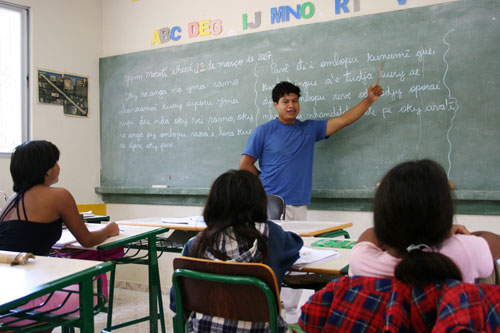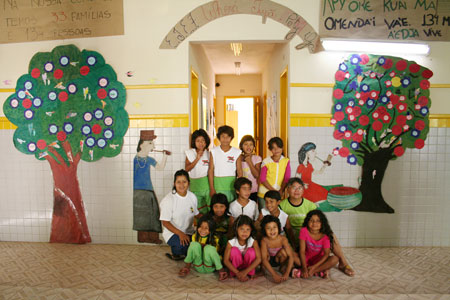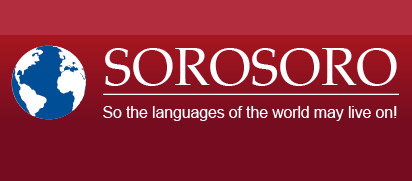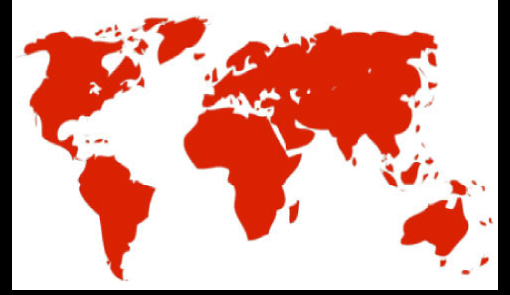Print  |
|


A bilingual Guarani/Portuguese school experience, Brazil
Posted by Andréa Eichenberg on May 2, 2011
By Andréa Eichenberger, anthropologist-photographer, PhD in anthropology co-advised between the Université Paris Diderot, France, and the Universidade Federal de Santa Catarin, Brazil, working on the construction of an indigenous self-image in the Guarani village of Yynn Morotĩ Wherá.

Marco Karai Moreira, teaching Guarani at the village school. © Andréa Eichenberger
Who speaks Guarani in Brazil?
The Guarani form Brazil’s largest contingent of indigenous population, with around 30,000 souls shared over seven Brazilian states.
The trend today draws towards Guarani-Portuguese bilingualism, especially among the young: Guarani is spoken daily in the villages, whereas Portuguese is mostly used upon contact with non-indigenous people.
Some of the speakers are still monolingual, however. Most of the elders, in particular, speak little or none of the society’s dominant language. Monolingualism also stands as a demonstration of resistance towards the assimilation of other cultures’ values.
How do indigenous languages officially fit in the country?
The officialization of indigenous languages remains the punctual initiative of a minority, but Portuguese is gradually losing its exclusivity as an official language these days.
Some Brazilian cities have taken a few steps forward in that direction, such as the municipality of Tacuru, in Mato Grosso do Sul, where Guarani has been officialized as second language, or the municipality of São Gabriel da Cachoeira in the state of Amazonas, which counts three official languages in addition to Portuguese: Nheengatu, Tukano, and Baniwa.
What’s more, thanks to the struggle of indigenous populations and the associations that supported them, the recent Federal Constitution, in 1988, recognized difference as a right of these populations.
In the realm of education, among others, it guarantees the right to a specific, cross-cultural and bilingual form of schooling. And this is how school eventually entered indigenous villages after having been considered stigmatizing for so long because it failed integration within the national education system.
The Guarani of the village of Yynn Morotĩ Wherá
In 2006 and 2007 I was granted the opportunity to work in the indigenous school of the village of Yynn Morotĩ Wherá (« Shimmer of Cristal Waters »), state of Santa Catarina, southern Brazil.
My Guarani contacts there believed that children need to understand the « white world » in order to defend some of their fundamental rights, for instance the right to land: the school was established in the community on request of its leaders so the local children could gain knowledge of the djuruá (the white). Portuguese was only supposed to be a means for negotiation, and its presence was to be supervised so it wouldn’t end up replacing Guarani. This has not been too difficult to enforce so far, and most of the children still begin school without knowing Portuguese.
The other objective of this school is the command of reading and writing in Guarani language, which is in fact present through the whole course of education, whether taught for itself or as language of teaching for other subjects.
One of the consequences is that what used to be usually taught orally is now starting to be written down. In 2008 and 2009, the first two bilingual Guarani-Portuguese volumes of a collection titled « Contributions to the revitalization of the Guarani culture » were published, the first on myths and legends, and the second on rituals and beliefs. Some myths were even reworked under different lights: text, drawing, staging, film, photography. School then becomes a place of promotion of cultural revitalization.
A perfect schooling system?
At the end of the day though, one can still wonder if this new school, supposedly so open and nourished with good intentions, bears only positive aspects. It intends to apply learning processes that are appropriate to the populations in question, introduce the use of their languages, and hand down their knowledge and traditional know-hows. Very well. But when the actual state implements a bilingual school system, one can also wonder if it isn’t a concealed way of marginalizing indigenous languages and eventually imposing the presence of Portuguese, so as to reinforce some degree of national linguistic unity.
Incidentally worth noting, some of the researchers (anthropologists, educators, linguists, historians, etc.) who played a part in training the Guarani teachers, and who were widely in favor of the culture’s revitalization, were constantly asking themselves: « is what we’re doing really the right thing to do? »
The Guarani, for instance, resisted learning Portuguese for a long time, but this native form of monolingualism is now gradually shifting towards Guarani/Portuguese bilingualism.

One of the classes of the Guarani school in 2007, with work on the village families displayed around the schoolyard. © Andréa Eichenberger








